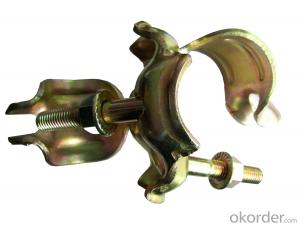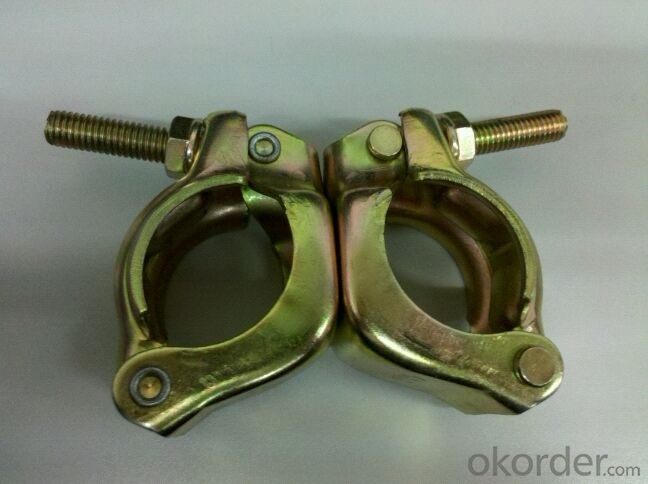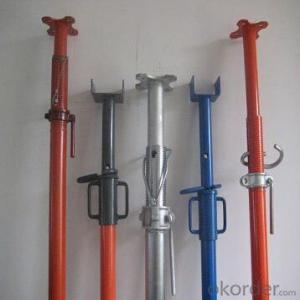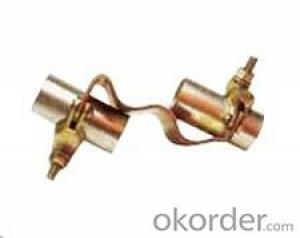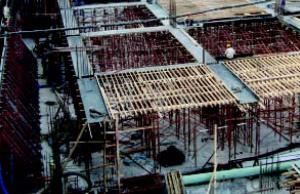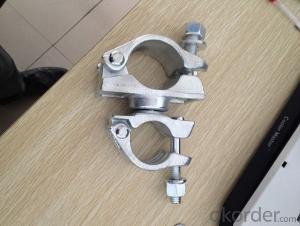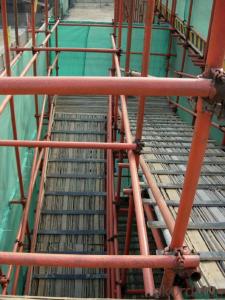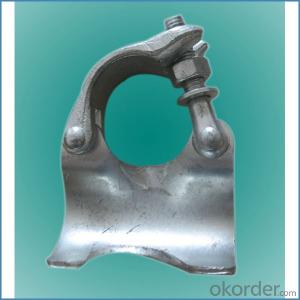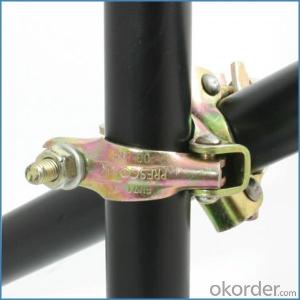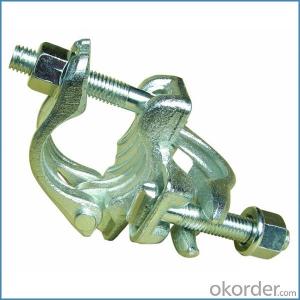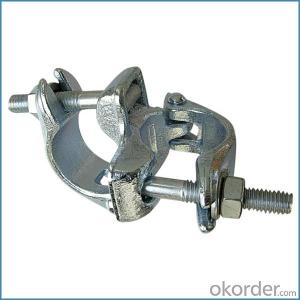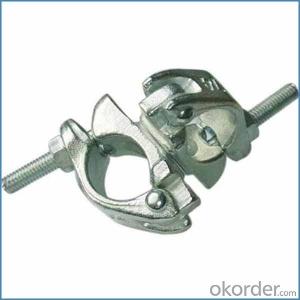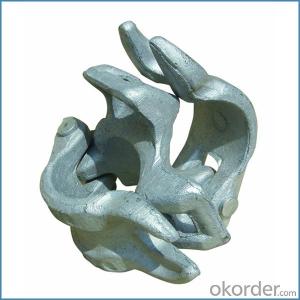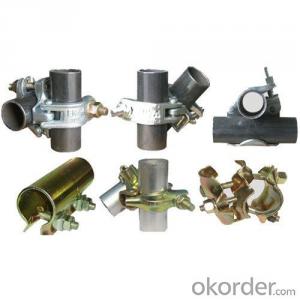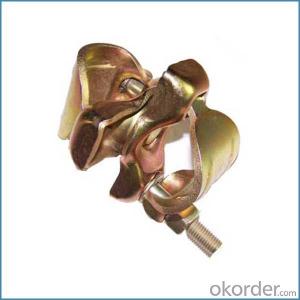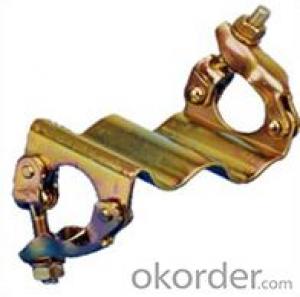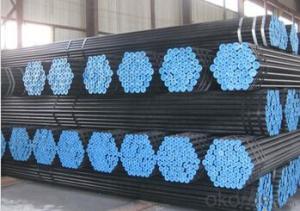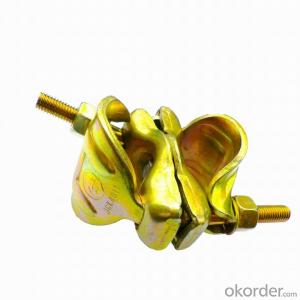Single Scaffolding Clamp british German Forged Type
- Loading Port:
- Tianjin
- Payment Terms:
- TT OR LC
- Min Order Qty:
- 1000 kg
- Supply Capability:
- 100000 kg/month
OKorder Service Pledge
OKorder Financial Service
You Might Also Like
Single Scaffolding Clamp british German Forged Type
Description
1.The scaffolding coupler is always used to connect the steel pipe as scaffolding system.
2.The often used coupler is swivel coupler and righ angle coupler .
3.We can provide types of scaffolding coupler according to your requirement.
4.Couoler can fix the 48.3mm scaffolding steel pipe tightly and make the whole scaffolding system more steadily.
Feature
(1)Excellent Anti-Breaking—Cold Pressed Steel
(2)Outstanding Resistance Deformation
(3)Strong Anti-Dropping Ability
Photo
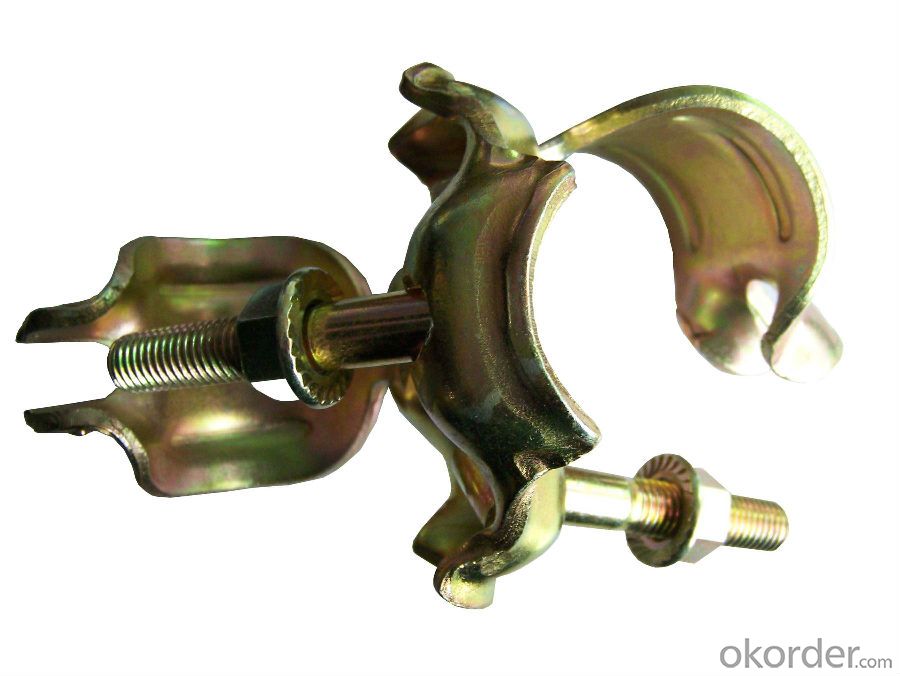
Parameter
| Material | Q235,345steel |
| Size | 48.3mm*48.3mm |
| Surface finish | Galvanized |
| Weight | 1.1kg around |
| Standard | BS1139,EN74 |
| Package | 25pcs/bag,steel pallet |
| Manufacture | As per customer requirement |
| Market | Africa, South America, the Middle East and Asia |
FAQ
Q: Are you a factory or trading company?
We are a state-owned corporation in China,dealing with various kinds of building materials.We have our holding subsidiaries.
Q: Where is your factory located? How can I visit there?
Our factory is located all around China.
Q: Can I get some samples?
Sample is free, customer only pay freight for the first time.
Q: Delivery?
10-30days. (5-15 containers)
Any question,feel free to contact us.
- Q: Can steel tube couplers be used for temporary or permanent scaffolding installations?
- Yes, steel tube couplers can be used for both temporary and permanent scaffolding installations. Steel tube couplers are designed to connect and secure scaffolding tubes, allowing for the construction of stable and reliable scaffolding structures. These couplers are typically made from high-quality steel, providing excellent strength and durability. For temporary scaffolding installations, steel tube couplers are often used due to their ease of assembly and disassembly. They can be quickly and securely attached to scaffolding tubes, enabling the construction of temporary platforms, walkways, and support structures. Once the temporary scaffolding is no longer needed, the couplers can be easily removed and reused for future projects. Similarly, steel tube couplers are also suitable for permanent scaffolding installations. They provide a robust and long-lasting connection between scaffolding tubes, ensuring the stability and safety of the structure. Permanent scaffolding installations, such as those found in construction sites or industrial facilities, require reliable and durable connections, making steel tube couplers an ideal choice. It is important to note that when using steel tube couplers for scaffolding installations, proper installation techniques and adherence to safety regulations should always be followed. Regular inspections and maintenance are also necessary to ensure the integrity and reliability of the scaffolding structure, regardless of whether it is temporary or permanent.
- Q: How do steel tube couplers affect the overall aesthetics of a scaffolding structure?
- Steel tube couplers do not have a direct impact on the overall aesthetics of a scaffolding structure. They are primarily functional components that provide strength and stability to the scaffolding system. The aesthetics of a scaffolding structure are typically influenced by other factors such as the design, materials, and finishes used, rather than the couplers themselves.
- Q: How do steel tube couplers contribute to the overall stability of a scaffolding structure during construction activities?
- The overall stability of a scaffolding structure during construction activities relies heavily on steel tube couplers. These couplers are crucial for connecting and securing the steel tubes that form the scaffolding system's framework. A significant contribution of steel tube couplers to scaffolding structure stability lies in their capacity to establish robust and inflexible connections between the tubes. The design of these couplers ensures a tight grip on the tubes, effectively keeping them in place. This guarantees that the tubes remain immobile, which is vital for maintaining the scaffolding structure's stability and integrity. Moreover, steel tube couplers are engineered to evenly distribute the load across the connected tubes. This minimizes stress concentration points and ensures an even distribution of the scaffolding system's weight. By achieving this balance, the couplers prevent excessive stress or strain on individual tubes, thereby reducing the risk of failure or collapse. Furthermore, steel tube couplers offer versatility, allowing for various connections and configurations within the scaffolding structure. Whether it involves connecting tubes at right angles, creating diagonal bracing, or joining different sections of the scaffolding, these couplers offer the necessary flexibility and adaptability. This enables the construction of scaffolding structures capable of withstanding different loads, heights, and configurations, thereby further enhancing their stability and safety. Overall, steel tube couplers are an indispensable component in ensuring the stability of scaffolding structures during construction activities. Their capacity to establish strong and inflexible connections, evenly distribute load, and provide versatility makes them an essential element in safeguarding the integrity and safety of scaffolding systems.
- Q: How do steel tube couplers contribute to the overall versatility of a scaffolding structure?
- Steel tube couplers play a crucial role in enhancing the overall versatility of a scaffolding structure. These couplers are used to connect different steel tubes together, creating a strong and stable framework that can withstand heavy loads and provide a safe working environment. One of the primary ways in which steel tube couplers contribute to versatility is through their ability to create various configurations and shapes. Couplers allow scaffolding tubes to be connected at different angles, enabling the construction of scaffolding structures in complex and challenging environments. This adaptability allows workers to reach different heights, work around obstacles, and access hard-to-reach areas, making scaffolding structures incredibly versatile. Furthermore, steel tube couplers are easily adjustable and reusable. Unlike traditional fixed scaffolding systems, couplers can be easily detached and repositioned, allowing for quick and efficient adjustments on the job site. This flexibility is particularly valuable in situations where the scaffolding structure needs to be modified or extended during the construction process. Additionally, steel tube couplers provide a high degree of stability and strength, ensuring the safety of workers and the integrity of the scaffolding structure. The tight connection created by these couplers eliminates any wobbling or movement in the scaffolding, making it a reliable platform for workers to carry out their tasks. This stability is especially important when working at great heights or in challenging weather conditions. Moreover, steel tube couplers are compatible with a wide range of scaffolding accessories and components. This compatibility allows for the integration of additional features such as guardrails, walkways, and stairs, further enhancing the versatility and functionality of the scaffolding structure. These accessories can be easily attached or detached using the couplers, providing flexibility to adapt the scaffolding system to specific project requirements. In conclusion, steel tube couplers contribute significantly to the overall versatility of a scaffolding structure. Their ability to create various configurations, easy adjustability, stability, and compatibility with other scaffolding components make them an essential element in constructing safe, efficient, and adaptable scaffolding systems.
- Q: What are the typical material specifications for steel tube couplers?
- The typical material specifications for steel tube couplers can vary depending on the specific application and industry standards. However, some common material specifications for steel tube couplers include: 1. Material Grade: Steel tube couplers are often made from carbon steel, which is a widely used material due to its strength and durability. The specific grade of carbon steel can vary, with popular options including ASTM A36, ASTM A572, and ASTM A500. 2. Tensile Strength: Steel tube couplers need to have a high tensile strength to ensure they can withstand the loads and pressures they will be subjected to. Typical tensile strength requirements for steel tube couplers range from 50,000 to 70,000 pounds per square inch (PSI). 3. Yield Strength: The yield strength of steel tube couplers is important as it indicates the maximum stress the coupler can withstand before it starts to deform permanently. Common yield strength requirements for steel tube couplers range from 30,000 to 50,000 PSI. 4. Elongation: Elongation refers to the ability of the steel tube coupler to stretch before it fractures. Higher elongation values indicate better ductility and resistance to brittle failure. Typical elongation requirements for steel tube couplers range from 20% to 30%. 5. Chemical Composition: The chemical composition of the steel used in tube couplers can vary, but it usually contains iron as the base element along with small amounts of carbon, manganese, silicon, and other elements. The precise composition depends on the desired mechanical properties and any specific industry standards. 6. Coating or Surface Finish: Steel tube couplers may have additional coatings or surface finishes to enhance their corrosion resistance, improve aesthetics, or provide better grip. Common options include galvanization, powder coating, or painting. It is worth noting that these are general specifications, and for specific applications, industry standards and regulations may dictate more stringent requirements for steel tube couplers. Therefore, it is essential to consult the relevant standards and guidelines to ensure compliance and optimal performance.
- Q: Can steel tube couplers be used to connect different diameter tubes?
- No, steel tube couplers are designed to connect tubes of the same diameter.
- Q: Can steel tube couplers be used in scaffolding projects with uneven terrain?
- Yes, steel tube couplers can be used in scaffolding projects with uneven terrain. Steel tube couplers are versatile and can be adjusted to fit various angles and levels, making them suitable for scaffolding on uneven terrain. These couplers are designed to connect steel tubes securely, providing stability and strength to the scaffold structure. Additionally, the adjustable nature of steel tube couplers allows for easy leveling and alignment of scaffolding components on uneven ground, ensuring a safe and secure work platform.
- Q: What is the minimum spacing between the crossbar and the pole spacing of the scaffold?
- Send a mail to you, but whether you can give the best answer, huh, huh
- Q: Are steel tube couplers suitable for scaffolding projects with limited access points?
- Scaffolding projects with limited access points can benefit from the use of steel tube couplers. These couplers are commonly utilized in scaffolding projects due to their ability to securely connect tubes, ensuring the stability and safety of the structure. They are convenient to attach and detach without the need for welding or drilling, which makes them an ideal choice for projects with restricted access. Steel tube couplers are versatile and compact, making them suitable for tight spaces and areas with limited entry points. They can be easily maneuvered and installed in locations where larger scaffolding components may not be practical. Moreover, despite being lightweight, they are still strong enough to withstand heavy loads, making transportation and assembly in areas with limited access a breeze. Furthermore, steel tube couplers are specifically designed to endure adverse weather conditions and heavy loads, providing a durable and long-lasting solution for scaffolding projects. Their sturdy construction ensures the stability and structural integrity of the scaffolding, even in challenging environments with restricted access. In conclusion, steel tube couplers are an excellent choice for scaffolding projects with limited access points. Their small size, ease of installation, and ability to withstand heavy loads make them a reliable and efficient option for such projects.
- Q: What are the typical applications or industries that use steel tube couplers in scaffolding?
- Steel tube couplers find extensive use in the construction industry for a variety of purposes, especially in scaffolding systems. Scaffolding serves as a temporary support structure for workers and materials during construction, maintenance, or repair projects. Steel tube couplers play a vital role in connecting and securing different components of scaffolding systems. Steel tube couplers are commonly utilized in the following sectors or industries for scaffolding: 1. Construction: Steel tube couplers are widely employed in construction projects of all sizes and types. Whether it involves constructing residential buildings, commercial structures, bridges, or industrial facilities, scaffolding forms an integral part of the construction process. Steel tube couplers ensure the stability and safety of the scaffolding structure, enabling workers to execute tasks at various heights. 2. Maintenance and Repair: Scaffolding is frequently used for maintenance and repair work on existing structures, such as buildings, bridges, or infrastructure. Steel tube couplers enable the assembly of scaffolding units that can be easily adjusted to meet the specific requirements of each project. This adaptability allows workers to access hard-to-reach areas and effectively carry out necessary repairs or maintenance tasks. 3. Oil and Gas Industry: The oil and gas industry heavily relies on scaffolding for various activities, including construction, maintenance, and inspection of refineries, platforms, and pipelines. Steel tube couplers play a crucial role in ensuring the stability and strength of scaffolding structures in such challenging environments. They are designed to withstand extreme conditions, including high temperatures, corrosion, and heavy loads. 4. Power and Energy Sector: Scaffolding is necessary during construction, maintenance, and repair work in power plants and energy facilities. Steel tube couplers are used to connect the tubes and other components of scaffolding systems, providing a robust and dependable support structure for workers. These couplers can endure the demanding conditions found in power plants, such as high temperatures and exposure to chemicals. 5. Infrastructure Projects: Infrastructure projects, including roads, bridges, tunnels, and railways, often require scaffolding for construction and maintenance purposes. Steel tube couplers are extensively used in these projects to ensure the safety and stability of scaffolding structures, enabling workers to access different areas for construction or repair work. In conclusion, steel tube couplers have widespread usage in the construction, maintenance, and repair industries, particularly in scaffolding applications. They offer a secure and reliable connection between scaffolding components, guaranteeing the safety and stability of the structure. These couplers are indispensable in various sectors, including construction, oil and gas, power and energy, and infrastructure projects.
Send your message to us
Single Scaffolding Clamp british German Forged Type
- Loading Port:
- Tianjin
- Payment Terms:
- TT OR LC
- Min Order Qty:
- 1000 kg
- Supply Capability:
- 100000 kg/month
OKorder Service Pledge
OKorder Financial Service
Similar products
Hot products
Hot Searches
Related keywords

